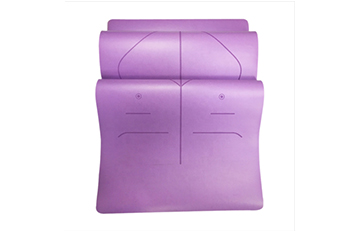Maintenance And Cleaning Methods Of Yoga Mats
The yoga mat is a partner that we have to be in close contact with every day. It records our sweat and engraves the mark of our continuous practice and progress. Of course, we must take good care of it. Therefore, it is necessary to clean yoga mats. Yoga mats that are not cleaned may contain bacteria, fungi, and dust mites. Among them, the bacteria can cause folliculitis, and the fungus can easily cause tinea corporis and athlete's foot. The biggest threat of dust mites to people with allergies is to induce allergic dermatitis and asthma. The Deluxe Yoga Mat Suppliers will share this article with you.
To ensure hygiene, it is best to clean it every other week. The easiest way to clean a Deluxe Yoga mat is to mix two drops of detergent with four bowls of water, spray it on the yoga mat, and then wipe it with a dry cloth. If the yoga mat is already very dirty, you can also use a cloth dipped in detergent to gently wipe the yoga mat, then rinse it with clean water, and then roll up the yoga mat with a dry towel to absorb the excess water. Finally, put the yoga mat in a ventilated place to dry.
Use as little washing powder as possible, because once the washing powder remains on the yoga mat, the yoga mat may become slippery. When cleaning the yoga mat, do not use a harder brush to scrub, which will cause the surface film to break and fluff. Also, when drying the yoga mat, remember not to expose it to the sun!
TPE yoga mats and PVC yoga mats have different cleaning methods because of different materials. TPE is currently the best environmentally friendly material, one of its obvious characteristics is that it does not absorb water and is easy to clean. Just follow the conventional cleaning method and wipe it with a dry towel.
The PVC yoga mat is made by the foaming process, so there are gaps between the molecules. During the cleaning process, a large amount of water can be sucked in and cannot be discharged completely. After washing with detergent, even after washing with water many times, the pressure will still be slippery. It feels that it becomes very heavy after seeing the water. Not only that, friends who use PVC yoga mats will know that the PVC yoga mat may not be able to be used normally after two or three days after cleaning. Therefore, after cleaning, the PVC yoga mat must be dried with a large towel and then placed in a ventilated place to dry thoroughly.
A small tool can be used for the usual maintenance of yoga mats: yoga towels. The main function of the yoga towel is to spread on the yoga mat to absorb sweat. When we are doing yoga exercises, the body will expel a lot of sweat along with the exercise. If sweat drops on the yoga mat, the yoga mat will become uncomfortable to stick and it will also slip easily. At this time, you can use this super absorbent drape on the yoga mat to effectively absorb sweat.
In addition, the yoga drape can also prevent the human body from inhaling bacteria on the yoga mat, because some facial movements need to be close to the yoga mat, there is a risk of inhaling bacteria or dust mites.
So personal drapes can be cleaned every day. Compared with thick yoga mats, are you more willing to clean yoga drapes?

After exercise, the unused mats should be rolled up and tied up with wool buckles, or laid flat.
Remember not to fold, otherwise, creases will appear, which will not be flat when used again, which will cause serious cracks.
Do not wash too frequently. Frequent washing will make the yoga mat absorb too much water, and the use of time and effect will be greatly reduced.
As long as we do a good job of daily maintenance of yoga mats, we can keep ourselves away from germs and stay healthy.
Yoga mats also need a master who can take care of them, so that they can be cleaner and use more assured.
 PREVIOUS: What Is Microfiber Towel?
PREVIOUS: What Is Microfiber Towel?